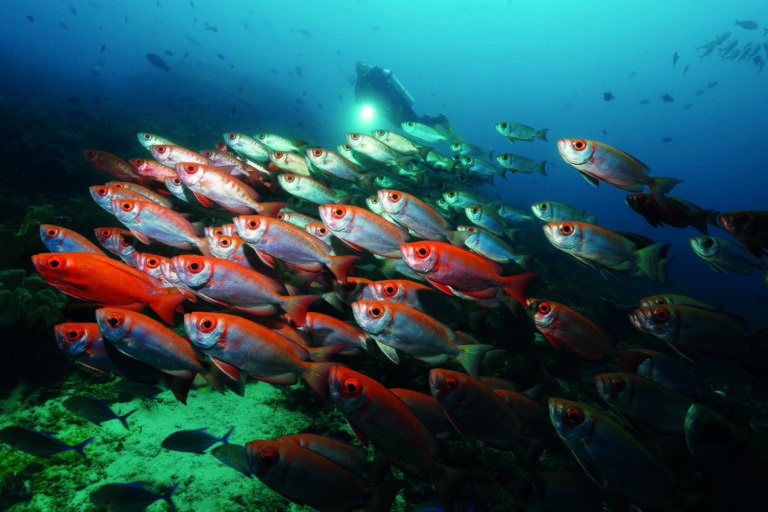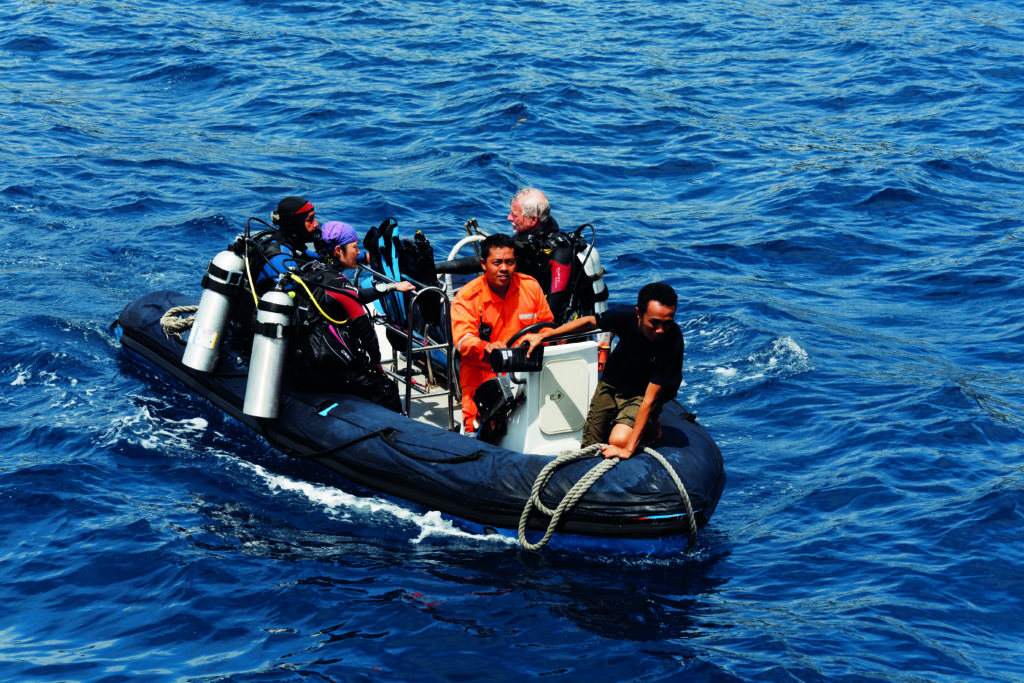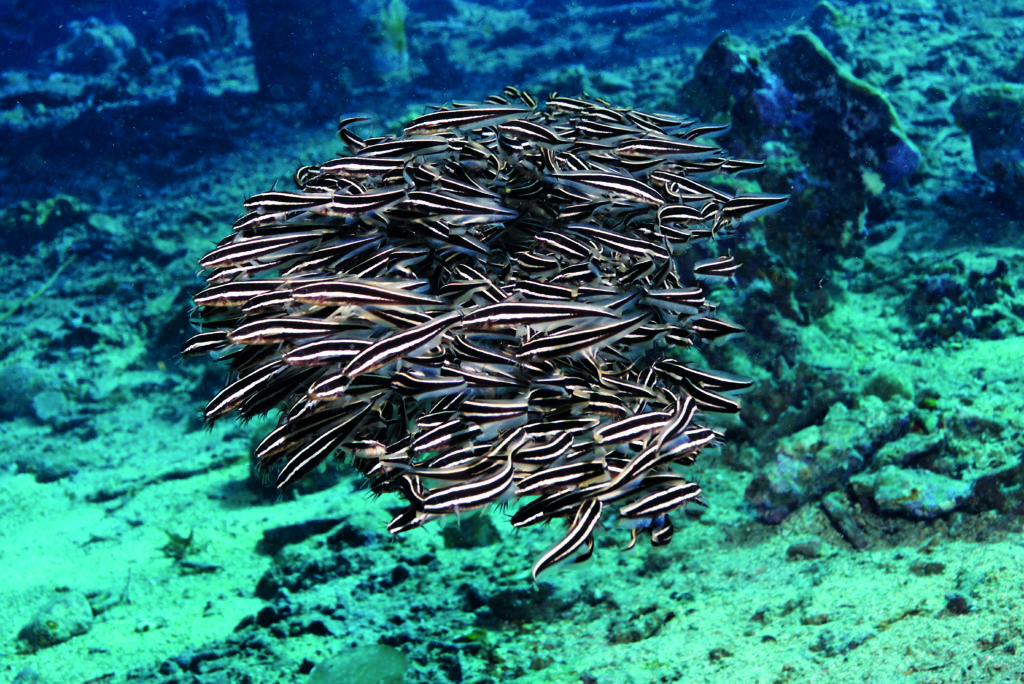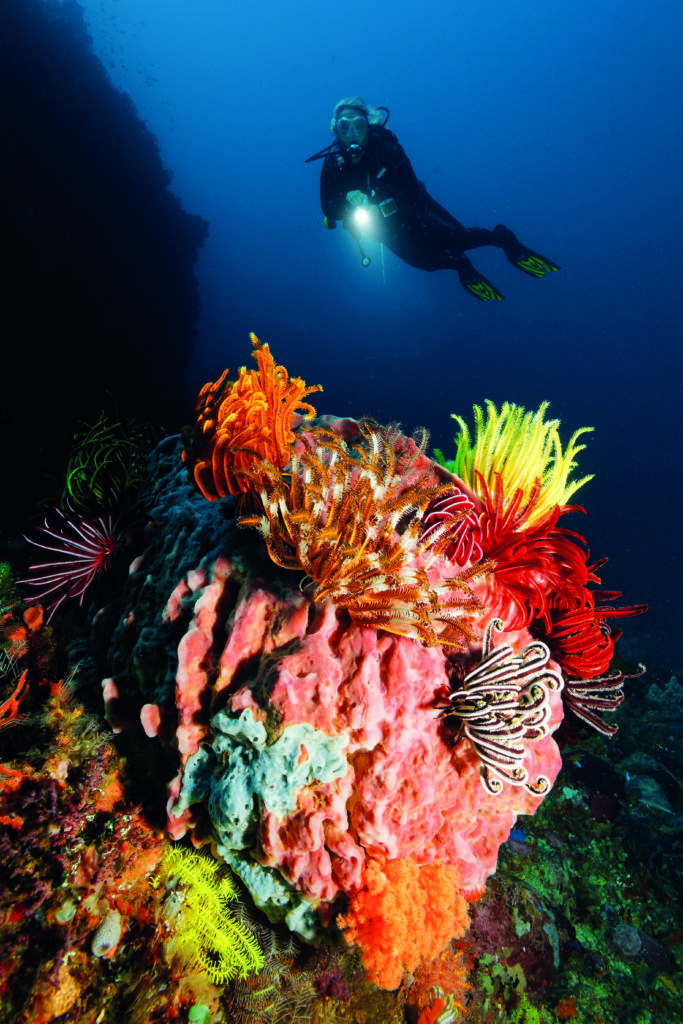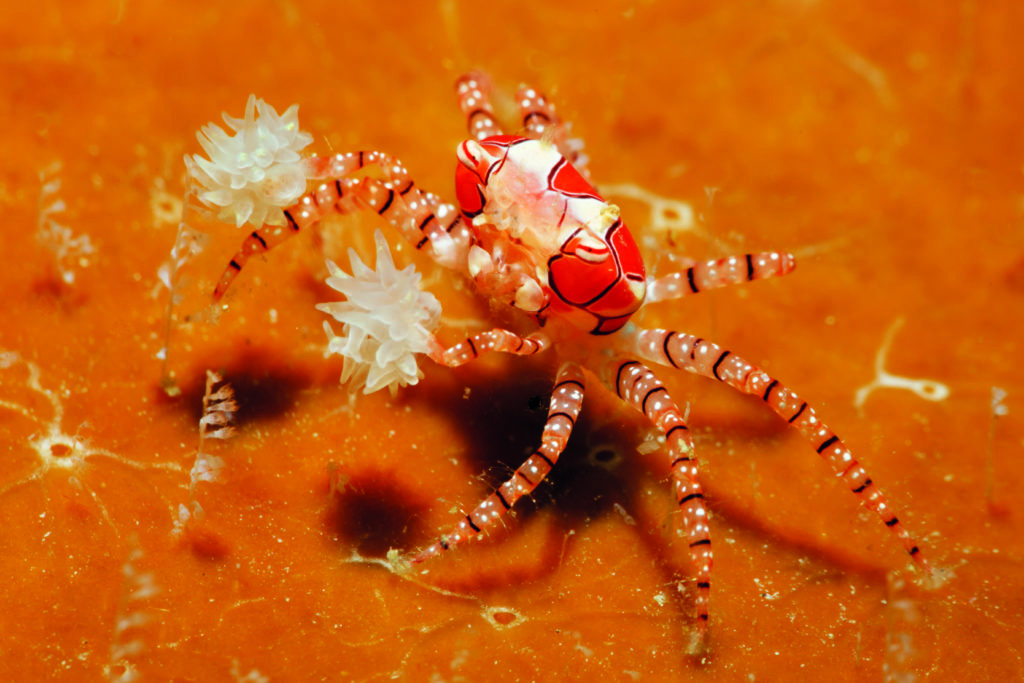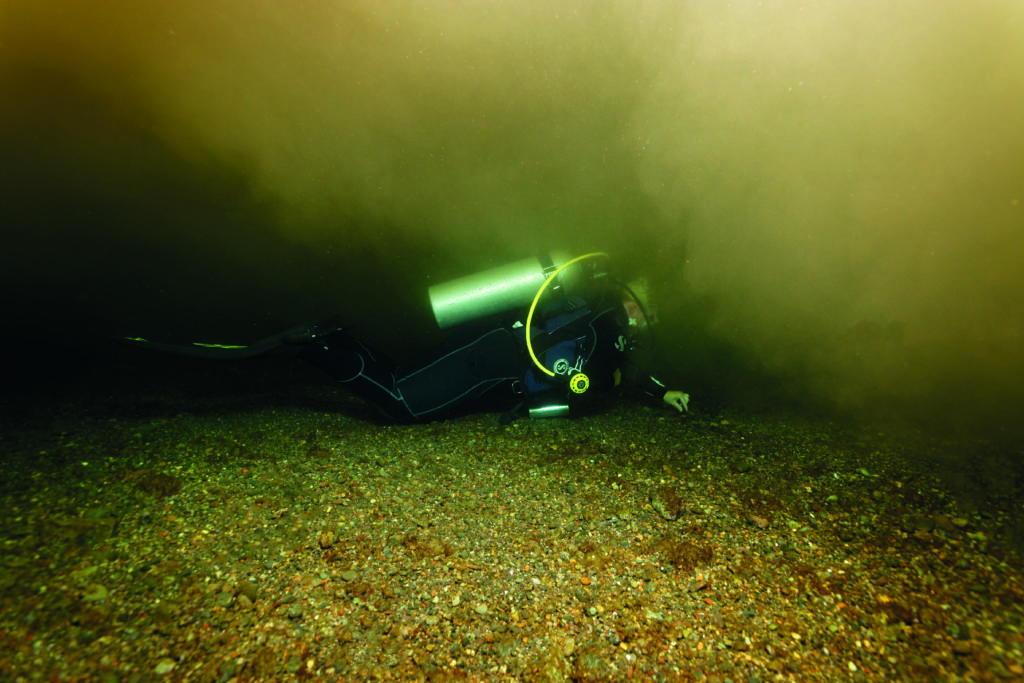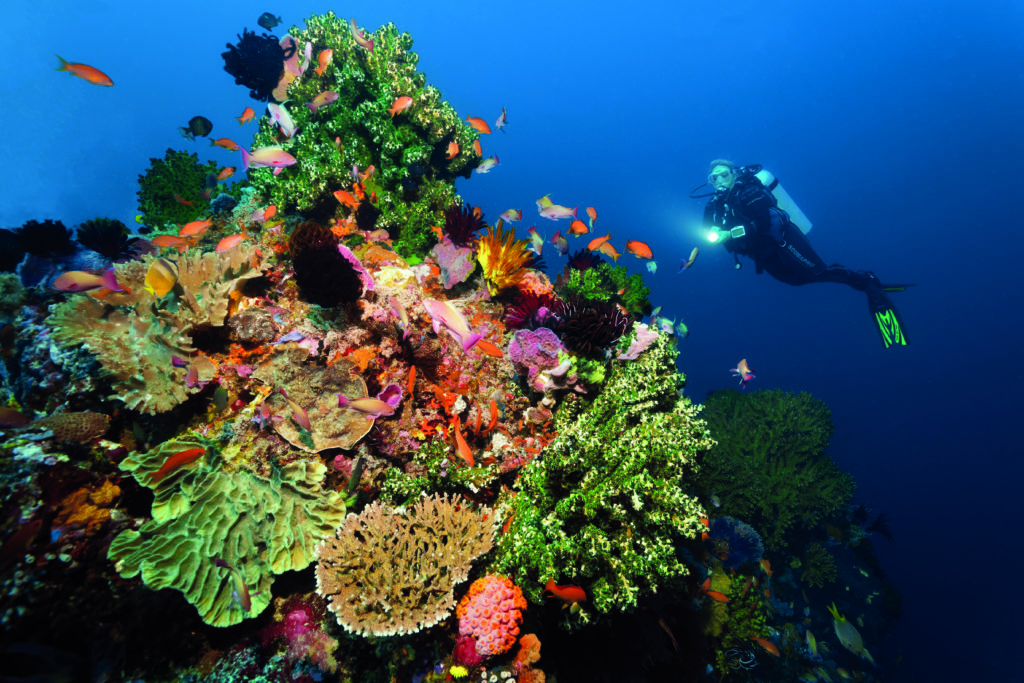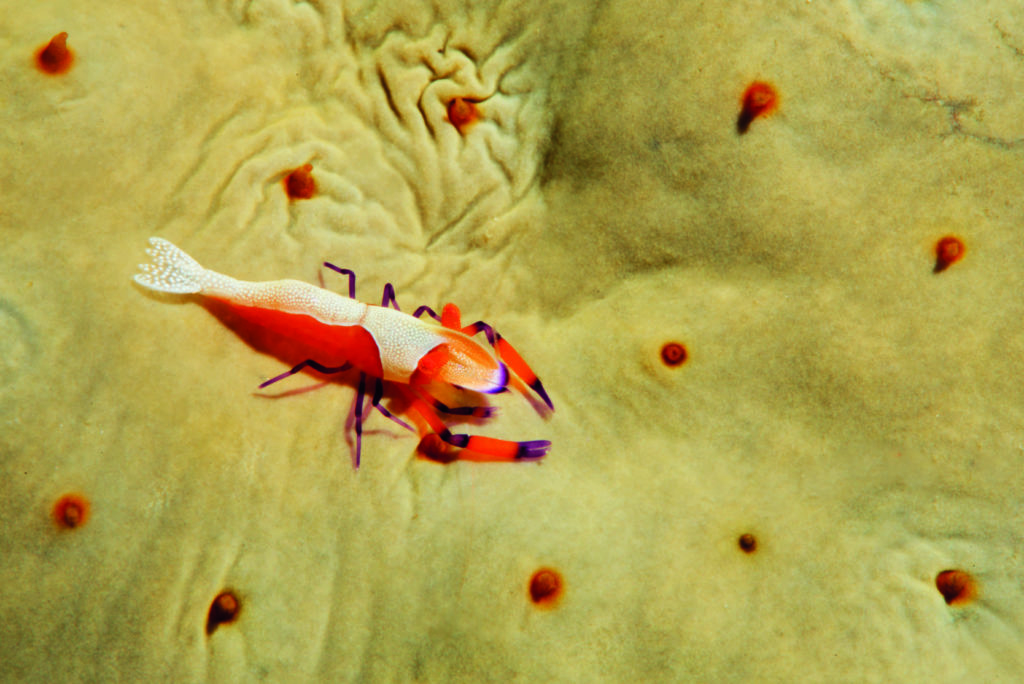Pure pleasure! The recipe originates from Indonesia, celebrates diversity and makes the most of exceptional ingredients, according to ROSE & UDO KEFRIG, who can’t get enough of a dish based on lashings of octopus, moray, frogfish, coral, sponge – and lots of fish.
We have squeezed into our wetsuits, grabbed our dive equipment and jumped in – to find ourselves in a brimming primaeval pot of fish chowder. Our Indonesian dive safari started from Maumere on Flores and will lead us out to Lembata, Pantar and Alor.
Diving around the islands along the way means variety – so many dive-sites, and incredible marine life. From little pygmy seahorses, fascinating mimic octopuses and shoals of fish, right up to big predators and an abundance of corals and sponges, everything is on the menu.
But although so much simply presents itself before our eyes, our advice remains to dive with a guide, and in that way get to see more then you ever envisaged.

Before being shown to our cabin, we are given a safety briefing covering life-jackets, life-rafts and housekeeping. Our safari ship is the Amira, which translates as “Princess”. We’re told that she is innovative, equipped with a state-of-the-art navigation system, technology, security and rescue equipment, and was built by indigenous craftsmen using the ancient phinisi boat-building traditions.
The 52m Amira offers nine comfortable en suite double cabins and one single, all with natural lighting. Meals are taken outside on the main deck or inside the restaurant, and there are air-conditioned lounge areas.
When not diving, guests are invited to soak up the atmosphere with a sundowner on the upper sun-deck, or chill on one of the other decks with a good book. Three times a day a tasty fusion of Indonesian and Western food is offered. Between meals, snacks, beverages and fresh fruit are available.
The dive-deck came as a nice surprise. Created “by divers for divers”, it’s a generously designed space with a fixed site for each guest, several rinse-tanks, plenty of surface space and a camera room.
Cruise director Ronan Debelius explained that the dive map of Alor is divided into two areas: the Strait of Pantar for wide-angle photography and the Bay of Kalabahi for muck-diving.
He also warned us about strong currents, with flows in the Pantar Strait reaching up to 20 knots, and strong whirlpools that even ships sometimes have to fight against. However, these currents serve to nourish the corals and the many tiny and bizarre creatures and fish.
The islands, of volcanic origin, are characterised by mountainous landscapes. You will find lonely beaches as well as dense rainforest with a rich variety of animal and plant species.
Kalabahi Bay
We arrived in Kalabahi Bay and watched the first group of divers get ready. A few of them had not visited Indonesia and the Coral Triangle before, and we knew they were unlikely to be disappointed by the muck-diving – all those rare, alien-like creatures that conceal themselves so cleverly to discover. There are currents and visibility there can be poor, but the experienced guides know their way around.
One of the best of these sites was Mucky Mosque, located just behind the entrance to the bay. Fish-traps, ropes, clothing and other man-made debris is found along the sloping reef, trapped around sponges and algae, but it does provide a home for weirdos such as spiny seahorses, zebra crabs, Coleman shrimps, squid and boxer crabs.
Pantar Strait
We sailed out of Kalabahi Bay into Pantar Strait, where the underwater landscape changes dramatically. Explosive marine life welcomes divers in this remote corner of Indonesia, and the dive-sites feature a central theme of fish life and high coral cover.
Fed by incoming currents from the Indonesian Sea and Pacific Ocean, the visibility on our trip didn’t fall below 25m and reached up to 40m.
In the north-east of Ternate Island, we got a taste of diving in the Pantar Strait. At the Edge, we came across a slope full of whip and soft corals that dropped gently to a depth of 10m, followed by a drop-off that plunged more than 100m into the abyss.
Never have I seen such giant barrel sponges before. My dive-computer reminded me all too soon that it was time to surface. I thought I had seen many impressive coral landscapes before, but you have to witness Alor for yourself.
Beangabang
You what? Beans-go-bang? It’s another dive-site and the word seems to roll beautifully over the tongue, just like our backward roll into the small bay in the south-west of Pantar Strait. At the Teluk Beang Reef you glide over a dark sandy bottom with hard and soft corals and beautiful sponges to admire schools of fusiliers and sweetlips swaying effortlessly in the current.
Our daily dives produced sightings of frogfish in all colours and sizes, scorpionfish, flabellina nudibranchs, crabs, numerous shrimps, lobsters and the most sought-after and well-camouflaged Rhinopias.
These fish, from the scorpionfish family, come in a variety of colours and species. They feed on crustaceans, cephalopods and fishes and employ a lie-in-wait strategy, remaining stationary and ready for prey that comes too near. By creating a vacuum with their mouth they are able to suck in unsuspecting passers-by in a split-second movement.
Pink Forest
Muck-dive sites with black lava sand are often referred to disparagingly as coral-free “deserts” but our dive at Pink Forest gave the lie to that cliché. We found many soft corals, with crustaceans occupying almost every crevice. Rare sea-slugs seemed to bask in the penetrating sun-rays, while yellow sea cucumbers, blue and green sea-squirts and harlequin shrimps were unmistakable with their very striking patterns.
Kel’s Dream
One dive was particularly rewarding. The site is renowned for its large pelagic fish, although to see them you could end up on an express train. Diving conditions are not always ideal, and the timing must be right.
Kel’s Dream teems with schools of small fish, including anthias and fusiliers. You need to kick your fins to hold your position because the current is usually quite strong but, once there, keep a look-out for barracuda and blacktip sharks.
Coral growth and diversity are impressive, but the strong and unpredictable currents often mean that the average size of individual corals remains relatively small, if in incredible densities and varieties. In the site’s wonderful world of macro you can find nudibranchs and small blennies, the latter ground-dwellers found mainly in rocky biotopes, staring curiously out from their hiding places.
Lamalera & Takbala villages
This trip was not entirely about diving and we enjoyed plenty of land excursions. Above water, colourful wooden fishing-boats chug back and forth from tiny islands. Laughing children in self-carved wooden canoes paddle like crazy towards the liveaboard in the hope of a few sweets or other giveaways.
From the old whaling village of Lamalera, sperm whales were hunted with harpoons for more than 500 years. This has stopped and nowadays schoolchildren demonstrate whaling dance elements, while the local women supplement the family income by selling ikat woven fabrics.
Another highlight is an excursion to the village of the Abui hill tribe on Alor Island. Until the 19th century, this indigenous group were headhunters, but now they welcome guests to Takbala village to watch them proudly performing their ritual dances. These are known as lego-lego, the dancers moving in a circular pattern and stamping their feet as moko drums and gongs are rhythmically beaten.
Diving in Alor is not particularly easy. The currents in this primaeval soup can be strong and unpredictable, but there is never a dive in Pantar Strait in which the pot doesn’t simmer with fish.
Even in Kalabahi Bay we experienced slight drifts while muck-diving, depending on the tides. Water temperatures can drop at any time because of the thermocline rising from the depths, so don’t forget to bring a beanie hat.
To enjoy the beauty of Alor to the full, divers must have a high level of confidence in the water – and appropriate safety equipment including a surface marker buoy (and the knowledge to deploy it), is essential.
Photography by Rose and Udo Kefrig / Team Oceanpics.de
Also on Divernet: Alor Aquamen, Alor Unto Itself
